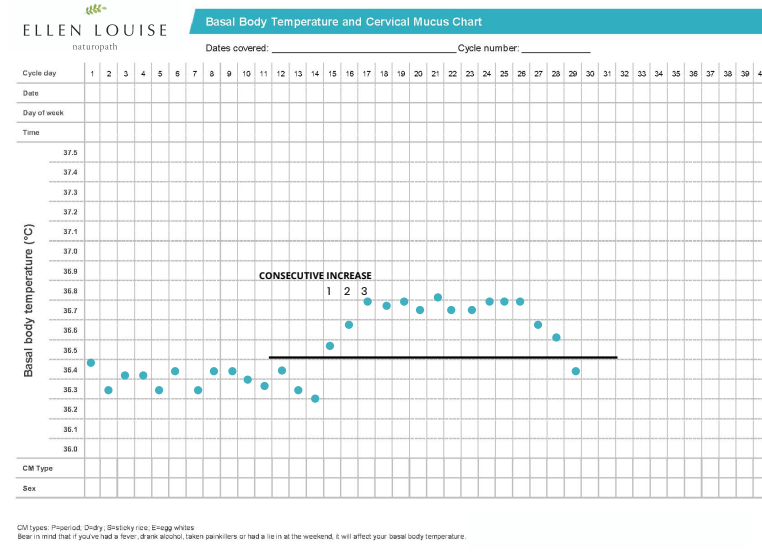Tracking Your Basal Body Temperature
Being body aware is such an incredible tool and skill to have. Knowing how to track your menstrual cycle is invaluable for women and couples to learn. By tracking your cycle you can learn the days that you are most fertile. This can be useful for those who are trying to achieve a pregnancy or it for those who are trying to avoid pregnancy.
Many women track their cycle using an app. This is a great start to become aware of your cycle and note down any changes. However, these apps are not always accurate and you should never rely solely on an app to tell you when you are ovulating.
Studies show that only 12% of people ovulate on day 14
There are two methods that are commonly used to track ovulation; basal body temperature tracking and cervical mucus tracking. When done accurately, both are extremely effective.
Women for decades have been measuring their morning basal body temperature to determine when they are ovulating. Why? Because after ovulation your body temperature increases. This tool has been used by many women, wayyyyyyy before the pill was created, for both the avoidance and achievement of pregnancy. It is important that you are measuring and tracking correctly to get an accurate reading.
If you are my client, you have most likely been shown the diagram below to learn about your cycle.
How to temperature track accurately?
Use a quality thermometer and take the temperature under your tongue. You need a thermometer that reads at least one decimal place but better if it’s two.
Take the temperature at the same time every morning before doing anything; going to the toilet, checking your phone, having a drink… anything.
Note that drinking alcohol the night before, if you are unwell or stressed, if you are travelling/holidaying, had a distributed sleep, not slept more than 4 hours or taking certain medications are all factors that can alter the reading.
Record the reading on a temperature tracking chart - see example below.
Temp Drop is a device that measures your basal body temperature for you. You wear a band around your arm to sleep and it measures it accurately for you and syncs to an online tracking chart. Using this link will get you 10% off as well
How does basal body temperature tracking work?
After ovulation there is a surge of progesterone. Progesterone is a hormone which slightly raises your basal body temperature. A normal average basal body temperature is between 36.1-36.5 degrees. The post ovulation increase is very minimal, I'm talking an average increase of 0.3 degrees. The small but significant increase remains from ovulation until the day you get your period. You need to track your temperature every day to get an accurate reading.
The first half of your cycle, pre-ovulation, is the follicular phase, where oestrogen is the dominant hormone. Oestrogen does not have an effect on body temp- after ovulation, progesterone becomes the dominant hormone, and this is how we see the change.
You measure your temperature at the same time every morning, and once you have received three consecutive increased readings you can now know that you have:
1. Ovulated
2. Know that the rest of this cycle (up until your period) you will not be fertile and you will not fall pregnant.
It is important to remember that the temperature increase is after ovulation. You are generally fertile in the 5 days leading up to ovulation. So this method is not determining the days that you are fertile pre-ovulation. However, after tracking for a few cycles, in addition to tracking your cervical mucus, you can determine the days you are most fertile.
Basal Body Temp Chart
How to track your fertile cervical mucus.
Being aware of your cervical mucus is another way to predict your ovulation. It differs from the temperature rise, as it appears several days before ovulation due to the pre ovulatory rise of oestrogen. Tracking both is the best way to accurately determine ovulation.
It is common and normal to have cervical mucus throughout the whole cycle. Not everyone experiences lots of cervical mucus, however, everyone should see some variations throughout the monthly cycle. The fertile mucus is unique, it has the same texture and look as egg white. You will see it on the toilet paper as you wipe or you can feel it in the vaginal opening. Some will see it on their underwear. It is a clear fluid that will feel slippery and stretchy. You should feel and see a lot of fluid. This is when it is at its peak and your fertile window is at its peak. The purpose of it is to help the sperm swim up the uterus to reach the egg.
Throughout the monthly cycle and in the lead up to ovulation it is normal to see changes in the mucus. The first sign that your fertile window is beginning is when you start to see changes in your cervical mucus. The early cervical mucus is generally sticky, thick and white- this is when your fertile window is low. As the cycle progresses, and the mucus becomes more cloudy/clear, thin and stretchy, your fertility increases. The fluid also increases in volume and you should not feel dry at the vaginal opening. As it becomes like an egg white texture; more clearer, slippery and wetter, this is when you are most fertile and ovulation is near. On the last day of this egg white type fluid, it is called your ‘peak’ fertile mucus, and is usually the day of ovulation.
How to track your fertile mucus
The build up to your ‘peak’ fertile mucus day is like the warning signs that ovulation is approaching. This is good for either achieving or avoiding pregnancy. It is important to note that not every cycle will look the same and it can vary each month. There are many factors that can contribute to the quality and timing of your cervical mucus, including; stress, poor nutrition, if you are unwell or if you smoke.
What to look out for:
Sensation? Dry, Moist,Wet
Colour? White, cloudy, yellowish, clearish, completely clear
Amount?
Texture? Sticky, tacky, creamy, gluey, stretchy, slippery.
How to observe:
Think about how the mucus feels at the opening of your vagina throughout the day
Look for mucus everytime you go to the toilet, observe before and after passing urine
Use your fingers to feel the texture
Observe before you go to bed and record on the same chart as the temp tracking chart at the end of everyday.
Being aware of when you are ovulating is a great way to learn about your fertility.
Even if you are not in the position that needs to prevent or plan pregnancy, knowing when and if you ovulate is super important.
Always consult your health practitioner to make sure this is right for you.



